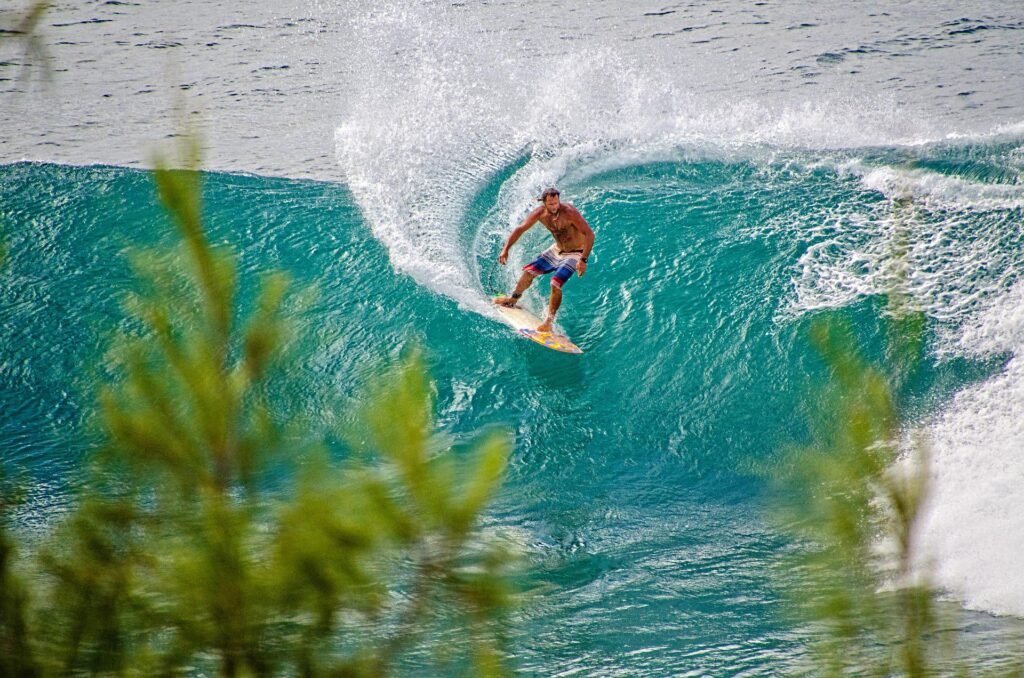
BOOT & FUN Berlin 2024 – We are exhibiting!
Hamburg, 17.11.2024 – After successfully participating in surf festivals in the north of Germany (Fehmarn) and a trade fair in the south,
Nowadays, surfing has become an integral part of our lives. Passionate surfers all over the world are in search of the perfect wave. They share the indescribable feeling of being one with nature and stoked while surfing through a “tube. Whether you’re a professional surfer, traveling the world for the best waves or just starting out in the surfing world. Anyone who has ever felt this feeling knows what we are talking about.
The origins of surfing trace back to ancient Polynesia, likely due to the ideal waves found there. There are even cave paintings from the 12th century showing surfers on waves. However, the exact date of the emergence of surfing is unknown. It is assumed that the origins lie in bodysurfing. Various aids such as wooden boards or canoe tips were tried out to make it easier to surf the waves. From Tahiti, surfing has spread to the Easter Islands, New Zealand and Hawaii, among other places.
As soon as surfing arrived in Hawaii, it flourished and became deeply embedded in the culture and religion. Due to its geographically favorable location in the middle of the Pacific, the island chain boasts numerous impressive waves.

The island paradise of Hawaii comes to mind when one thinks of impressive waves and passionate surfers. And not without reason: Hawaii is considered the birthplace of modern surfing. The deep passion and strong connection to the sea is rarely found in any other culture.
Another important part of Hawaiian tradition is that all life originates and ends in the ocean. So it’s no wonder that the locals have integrated surfing directly into their lives.
The life of Hawaiians with the sea and their daily interaction with surf and waves has over time generated many specific terms within their surfing tradition. Surfing played such a special role in everyday life that work became a minor matter as soon as big waves could be seen on the coast. Ceremonies and incantations were held to summon new waves, when there were no storms for some time. Men, women and children all enjoyed the magic of the sea together. The best waves were strictly reserved for the tribal leaders and there were many rules about who was allowed to surf which waves. The famous King Kamehameha I is said to have been a very talented surfer who was still highly regarded long after his death.

On his voyages of discovery and search for riches, James Cook and his crew came across the Hawaiian Islands in 1778, which were initially intended as a place to spend the winter. They watched locals mastering the waves with self-made surfboards. The first records of surfing can be found in the diaries of Cook and his crew. However, the conquerors quickly realized the strategic value of the islands and began to suppress the culture of the inhabitants and re-educate them. The Hawaiians were forced to wear different clothes and learn a new language.
Introduced diseases, control and threats to the population and a new religion ensured that the original and laid-back surf culture almost came to a standstill. Christianity prevailed in the middle of the 19th century. The number of the indigenous population has declined significantly due to new diseases, and the influence of the conquerors has been so extensive that surfing has hardly been practiced in Hawaii anymore. Fortunately, there were some stubborn Hawaiians who did not let their passion be taken away and the cultural heritage of surfing was kept alive.

By the end of the 19th century, Waikiki had become the center of surfing, where Hawaiian surfers gathered together to feel the power of the ocean. At the same time, the town became a popular destination for wealthy vacationers. They were interested in the culture and natural beauty, were fascinated by the surfers and tried surfing themselves. One of these vacationers was the author Jack London, who recorded and disseminated his observations about the surfers. With the founding of the first surf club “Outrigger Canoe and Surfboard Club”, surfing was back in vogue and surfers competed for the best waves in Waikiki.
In 1907, Hawaii’s surfing legend George Freeth was invited to California to celebrate the new railway line from Los Angeles to Redondo Beach and to impress spectators with his surfing tricks. We owe further spread of the sport to Duke Kahanamoku, also known as “The Duke” or “The Big Kahuna,” who, during a trip for a swimming competition in 1914, inspired numerous Australians to take up surfing. Duke was one of the indefatigable locals who continued to surf during times of oppression.
In the years that followed, more and more like-minded people fell in love with surfing. Surfboards and accessories were constantly developed and the unique “stoke” continued to be shared and spread. When Hawaii was officially declared the 51st state of the USA in 1959, there was a tourism boom on the islands, and the sport of surfing became increasingly popular.

Initially, different types of wood and shapes were probably experimented with to determine which option worked best with which wave. In Hawaii, eventually two types of surfboards were produced. A chief always received a special surfboard called the “Olo,” which was made from Wiliwili wood. The “Alaia” made of Koa wood was used by the rest of the people. The surfboards back then were 2.0 m – 3.5 m long and weighed around 50 kg, sometimes even more.
The strict rituals involved in making a surfboard reflect the special respect for nature and ensured the protection of surfers in the sea. Here’s the translation: “Initially, an offering to the gods in the form of a fish was made, and a prayer was recited, after which the appropriate tree was allowed to be felled. The desired shape was carved with a stone axe and corals or shells. After completion, another ceremony was held to inaugurate the surfboard.
When the sport boomed again at the beginning of the 19th century, many surfers experimented with different woods to reduce the weight. With the invention of water-resistant glue in the First World War, these could now be used in combination. A huge step forward in the development of the surfboard was made by Tom Blake from California, who invented the modern “hollow” surfboard. Blake is also regarded as the inventor of the fin. The development of boards has also led to ever narrower and shorter shapes. A major milestone was the use of fiberglass, which drastically reduced the weight.
Nowadays, the diversity of surfboards is as varied as the surf spots in Hawaii. Read more about this in our blog “All about surfing equipment – what do I need for surfing?” or under “1. Overview of different surfboards”.

The notorious wave ‘Pipeline’ on the North Shore of Hawaii is not the only surfing spot in the world that has it all. In icy cold off Iceland’s coast or in tropical atmosphere in Fiji – surfing fun is available everywhere, with the appropriate wetsuit Some areas are particularly popular among surfers. These include Uluwatu in Bali, Teahupo’o in Tahiti, Bells Beach in Australia, La Jolla in California and Jeffrey’s Bay in South Africa. There are also numerous surfing opportunities in Europe, especially in France, Spain and Portugal. Nazaré in Portugal, for example, is world-famous for its huge waves.
The type of surfing is determined not only by the surf, but also by the type of surfboard. The very long “guns” are used for big wave surfing, for example, and can be used for big waves in Nazaré. The classic “shortboard” can be used in numerous conditions and is also suitable for larger waves, catering to daring surfers who want to try tricks like an air, 360, or snaps. With a ‘longboard,’ an elegant surfing style is associated with smaller and medium-sized waves, as well as the classic hang 5 or 10. A “fish” is usually wider than a shortboard and offers a little more stability. The so-called malibu or mini malibu is the perfect surfboard for beginners due to its longer and rounder shape.

Numerous surf legends have shaped surf culture from the very beginning. Gerry Lopez, for example, was born on Oahu in 1948 and is considered a master of the pipeline. His innovation of “Lightning Bolt Surfboards” was a great success in the 1970s and is still widely used today. Other names such as Eddie Aikau have also left their mark on the world of surfing. Eddie was a lifeguard and passionate big wave surfer. No wave was too big for him and he was the first to dare to tackle a 30ft wave. After his death in 1978, the Quicksilver in Memory of Eddie Aikau contest was introduced, which was only allowed to take place with a wave size of 30ft or more. Every surfer probably knows the saying “Eddie would go”.
Numerous competitions have already been held, but with the development of the World Surf League (WSL), professional surfing has become increasingly popular. On the Championship Tour, the best male and female surfers travel around the world to compete against each other.
Anyone who is interested in the sport knows surfing icons such as Kelly Slater, Andy Irons, Filipe Toledo, Italo Ferreira and Kanoa Igarashi. Among women, there are talented professionals such as Carissa Moore, Tatiana Weston, and Bethany Hamilton. During the tour, the pros surf the best waves in the world. These include the Hawaiian Pro in Haleiwa, the J-Bay Open in Jeffrey’s Bay and the Outerknown Tahiti Pro in Teahupo’o. WSL also offers other competitions such as the Longboard and Junior Tour as well as a Big Wave competition. From experimenting with wooden boards in ancient Polynesia to today’s variety of surfboards and accessories, tricks and competitions: It’s hard to imagine a world without surfing.

We would be delighted if you could be inspired by the magic of surfing. We generally recommend that beginners take a surf course. If your enthusiasm for surfing has been awakened, we want to continue to support you on the Stoked Zone and offer you suitable products. In our blog “Used surf equipment“, for example, you can read about what you need to consider when buying used surf equipment. We have also listed tips on used equipment for other surf sports such as windsurfing, kitesurfing and SUP in this blog.

Hamburg, 17.11.2024 – After successfully participating in surf festivals in the north of Germany (Fehmarn) and a trade fair in the south,

Hamburg, 10.12.2024 – Boot & Fun Berlin was another success for the development of the Stoked Zone as a platform for surf sports

Hamburg 25.11.2024 We are very pleased to announce our partnership with the premium surfskate brand Curfboard.Curfboard is a German company with a